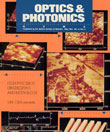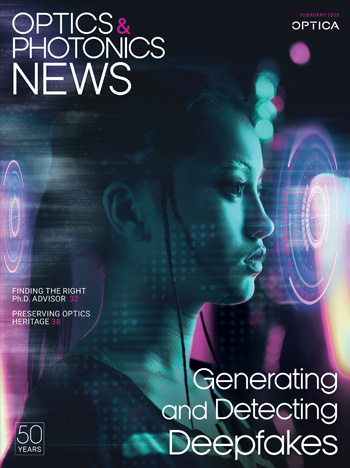
May 1991 Issue
- The ruling and replication of diffraction gratings
- Optical wavefront metrology
- Precision metrology for studying optical surfaces
- Surface metrology testing frequency footprints
- The making of binary optics
- Optical lithography: Where will it end?
- Soft x-ray projection lithography
- Precision measurements on optical fibers
- Optical standards technical committee on the move
- The blue arcs: An electrifying visual phenomena
- Browse all Issues
Feature Articles
Optical wavefront metrology
Optical wavefront or figure metrology is concerned with measuring the departure of a spherical wavefront or optical surface from a purely spherical (or flat as a special case of spherical) form. Form resolution can be as good as 2.5 nm, but environmental effects often limit repeatability at any point on the surface to several times this. Lateral resolution is generally no more than 100 cycles per aperture diameter and often substantially less. The maximum departure from pure spherical form that can be measured accurately—that is, to within a few times the resolution of the instrument—is about 10 wavelengths of visible light or perhaps 5 μm.
by Robert E. ParksPrecision metrology for studying optical surfaces
Precision metrology can help provide a better understanding of one of the major puzzles in optics— how does light interact with a surface and, in particular, with the roughness on a polished optical surface? The surface is made up of atoms whose spacings are of the order of a few angstroms. The atoms can be arranged in a completely random manner, in the uniform order of a perfect single crystal, or, more generally, in the form of tiny crystallites that are randomly ordered relative to one another.
by Jean M. Bennett, Virgil Elings, and Kevin KjollerSurface metrology testing frequency footprints
This article focuses on the spatial frequency content of optical surfaces and the corresponding frequency response of optical surface test instrumentation. The frequency components (amplitude and frequency distribution) of the surface, and the associated instrument's response function, may be as important in evaluating the performance of a surface as the modulation transfer function for specifying the performance of a lens. This article reviews several parameters necessary to describe the instrument response function for roughness testing. A recent review article discusses the history and development of several techniques for testing the figure of optics. Other references describe interferometry in greater detail.
by Thomas C. BristowThe making of binary optics
In a development that parallels the evolution of single transistors to integrated circuits to microprocessors, binary optics is the enabling technology in the transition from macroscopic optics to arrayed micro-optics to integration of optical subassemblies with built-in processing functions. Binary optics is a broad based diffractive optics technology that uses lithography and micromachining to create novel optical devices and to provide design freedom and new materials choices for conventional optical designs. It piggybacks on advanced VLSI (very large scale integration) fabrication technology and is complemented by computerized optical design procedures.
by Michael W. Farn, Margaret B. Stern, and Wilfrid VeldkampOptical lithography: Where will it end?
Optical lithography is one of the most costly and highly leveraged technologies in the complex process of manufacturing integrated circuits (ICs). The leverage comes from the number of IC "chips" that fit on a silicon wafer and the density of circuit functions on the chip. The number of wafer processing steps is unchanged by the number of chips on the wafer. As IC features become smaller, device functionality and speed improve while power consumption decreases. These factors all improve value and reduce the cost per chip. The integrated circuit process is much like a multilayer circuit board, only more complex. Some of the more complex devices like dynamic memory or DRAM contain as many as 20-25 different layers. Any gains in performance or productivity at each layer are multiplied by the number of layers.
by John BruningSoft x-ray projection lithography
As the VLSI (very large scale integration) industry demands cameras that can produce images of ever greater resolution, lithographic technology has responded by developing lenses capable of diffraction limited imaging. When the need arose for sub-half micron features, the industry sought higher resolution by using shorter wavelengths, the near UV in the mercury i-line at 365 nm, and soon the deep UV using excimer lasers at 248 nm and, eventually, perhaps even 193 nm. However, as we increase resolution we decrease the depth of focus, and patterns produced by poorly focused imaging is a major source of defects in the final circuits.
by Bell Lab Soft X-ray Projection Lithography GroupPrecision measurements on optical fibers
As the optical fiber industry matures, the precision and accuracy of measurements improve to further reduce cost and enhance performance. The divestiture of AT&T has resulted in a multivendor marketplace that must rely on common measurement techniques to ensure product compatibility. Such a set of voluntary standards has been a goal of the Telecommunication Industries Association (TIA). Their standards provide a system of documentation to efficiently procure fiber and other lightwave components.
by Douglas L. FranzenOptical standards technical committee on the move
With the passing of the 3rd Plenary Meeting of ISO/TC172 in Las Vegas in April, it is appropriate to recap the work of this very active optical standards Technical Committee (TC). Twelve countries participate actively in the TC, while 17 other have observer status and three scientific bodies, including ICO, have liaisons. In the last year, 383 experts from 15 countries participated in formulating optical standards as part of 7 active subcommittees (SCs) within TC172. Some 91% of the experts were from five countries; France, Germany, Japan, the United Kingdom, and the United States.
by Robert E. ParksThe blue arcs: An electrifying visual phenomena
The proliferation of red LEDs on electronic equipment of every sort has made it easy to observe one of the more interesting entoptic phenomena. Normally, visual experiences are caused when light stimulates the retina, the network of nerve cells at the back of the eye. Entoptic phenomenon are produced when something other than light stimulates the retina. Thus, if you gently poke the side of the eye with your lids closed, you will see a spot of light on the opposite side of the visual field. This so-called pressure phosphene is caused by mechanical stimulation of nerve cells.
by Jeremy M. Wolfe
![Illustration of a synapse in the brain. [Getty Images]](https://opnmedia.blob.core.windows.net/$web/opn/media/images/articles/2025/0425/departments/202504-cover-web.jpg?ext=.jpg)
![Fiber draped around a hand, demonstrating its flexibility. [Photo by Z. Wang and L. Wei]](https://opnmedia.blob.core.windows.net/$web/opn/media/images/articles/2025/0325/departments/202503-cover-web.jpg?ext=.jpg)
